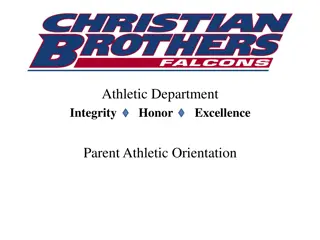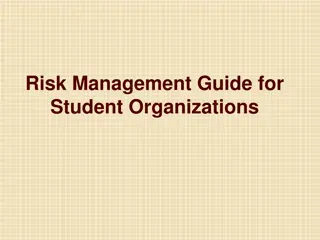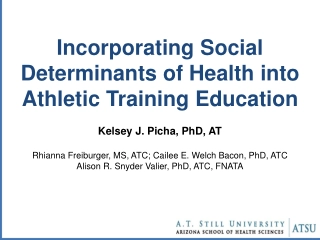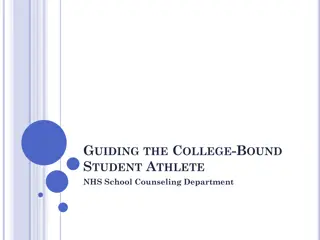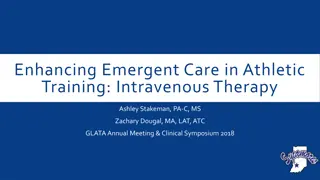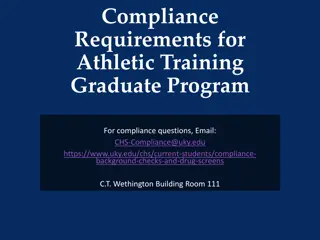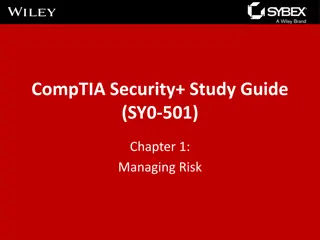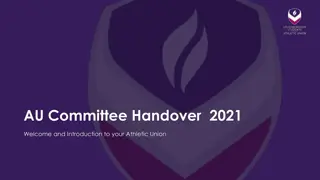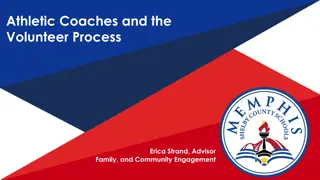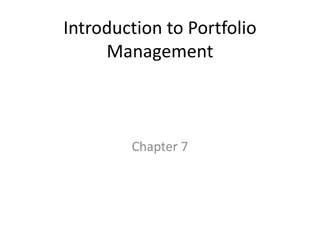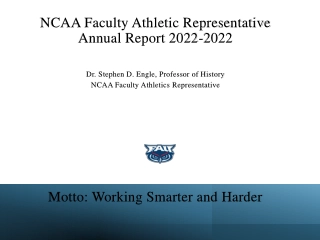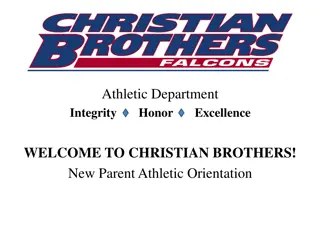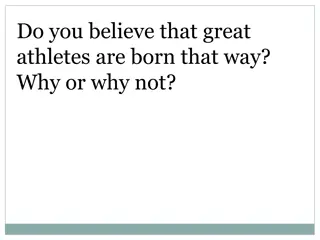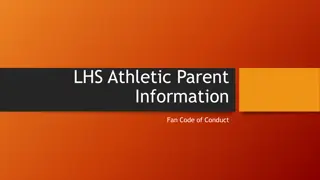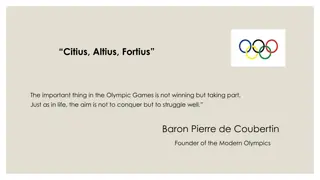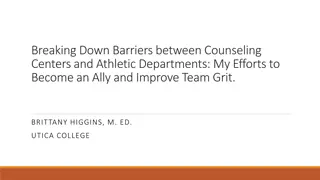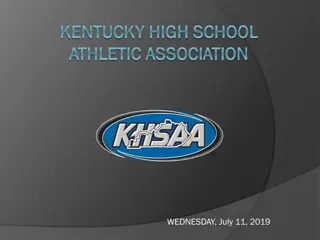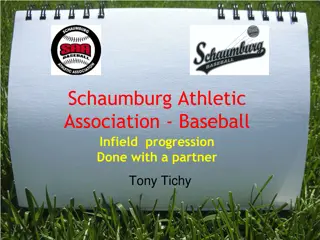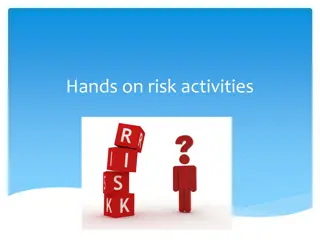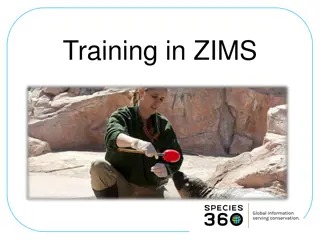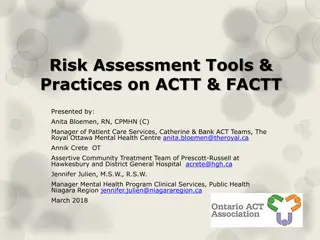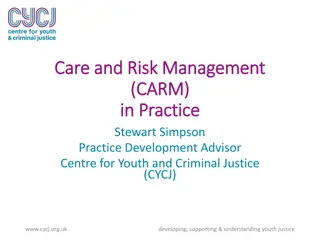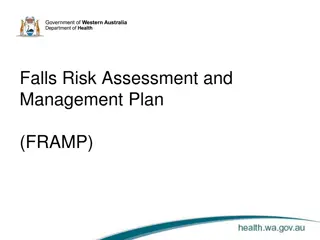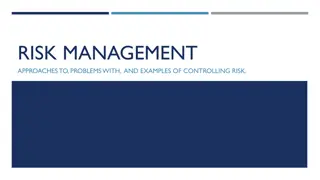Comprehensive Athletic Training Risk Management Guide
This comprehensive guide covers various aspects of risk management in athletic training, including safety protocols, emergency action plans, roles of training staff, athlete development considerations, head injury prevention and treatment, recovery guidelines, and resources for creating a risk management portfolio. It emphasizes the importance of athlete safety and well-being throughout all stages of training and competition.
Download Presentation

Please find below an Image/Link to download the presentation.
The content on the website is provided AS IS for your information and personal use only. It may not be sold, licensed, or shared on other websites without obtaining consent from the author. Download presentation by click this link. If you encounter any issues during the download, it is possible that the publisher has removed the file from their server.
E N D
Presentation Transcript
Athletic Training Staff and Support Staff Risk Management Risk Management and and Principles of Physical Principles of Physical Training Training- -Fitness Plans Fitness Plans for for All Athletes All Athletes Risk Management Adaptive Athlete Training Have a Plan Portfolio design homework
#1 #1 - - Steps to Safety 101 Steps to Safety 101 1. ***practice prep + area map + staff/players responsibilities + daily checklist 2. Emergency Action Plan (EAP) ***Steps in case of injury/emergency (field card) 3. Athletic Training Staff & Support Staff Roles ***Injury Prevention & Care + Roles within your program (Mine = Coach+start ***Contact persons (priority list and # s) ***Follow up procedure / paperwork-communication-info cards Facility and Equipment Inspection - Staff (coaches) and player RESOURCES: Sabock Text Book / Canvas examples / Individual research PORTFOLIO DESIGN: Need TRI for EACH POINT
Risk Management (Portfolio) Risk Management (Portfolio) THINK BACK TO THE BEGINNING = Athlete Development 1. Physically 2. Psychologically 3. Socially Long term versus short term concern for student-athlete *Your Leadership Philosophy and Code of Ethics Certified Athletic Trainers/Support staff Roles Facility and equipment inspection checklist Emergency Plan (checklist-card-contact # s)
HEAD INJURIES HEAD INJURIES NCAA Concussions: Don t hide it, report it, take time to recover video Youtube ncaa concussion (video 9 min) Head Injuries concussions (nfhs video) NCSS- National Center for Sport Safety Youtube ncss parent/athlete concussion (video (4 min)
TREATMENT TREATMENT RULE 1 remove athlete from play Be supportive of athlete s injury Get certified trainer / medical staff to evaluate properly asap Developmental Website: www.ncaa.org/health-safety Heads Up Website: www.CDC.gov/Concussions
RECOVERY RECOVERY 90% of head injuries will recover fully in 7-10 days (no activity cannot raise heart rate) PIAA requires minimum of 7 days and athlete must be cleared by physician not a coach / parent / student-athlete 10% not at greater risk during this period if 2ndhead injury occurs = compound original trauma and lengthen overall recovery time Better to miss 1 game vs. season - career
Heat illness prevention Heat illness prevention USF sports med Dr Eric Coris beat the heat: tips on preventing heat illness http://www.youtube.com/watch?v=IJQUtfQaTDs What can we learn use in Portfolio?
SYMPTOMS SYMPTOMS light headed - weak dizzy muscle cramps fatigue cold chills headaches rapid heart rate difficulty concentrating nauseated
PREVENTION PREVENTION hydration tips hydration tips 24 ounces of water or sport drink 1 hour before activity 12 ounces of water 30 min before activity Weigh yourself before activity Drink 10 ounces every 15 mins Weigh yourself after activity Replace 16 ounces for every pound of weight lost during activity *nutrition add to portfolio Fitness Plans
Workshop OR Homework (Portfolio) Workshop OR Homework (Portfolio) Developing a Safety Plan Developing a Safety Plan Group Activity (5-7 people) Pick 1 sport divide into 3 phases *handout (see next slide - template) Pre season In season Post season STEP 1 = Determine facility and equipment needs AND Facility-equipment safety checks (what / how / who) STEP 2 = List Safety concerns for athletes *concussions, heat-hydration, strains-sprains, etc . STEP 3 = List Trainer / Staff roles-communication STEP 4 = EAP- emergency action plan (steps = # s / follow up)
493 RISK MANAGEMENT PLAN SPORT: LEVEL: *SAFETY CARD make a pocket size version for all to carry always (field and travel) PRE-SEASON IN-SEASON POST-SEASON FACILITY & EQUIPMENT SAFETY NEEDS-CHECKS ATHLETE SAFETY CONCERNS AT STAFF / TRAINING AND STAFF ROLES EAP Emergency Action Plan (steps)
Adaptive Outreach in Sport Adaptive Outreach in Sport Coaching Challenge Coaching Challenge Inclusiveness within your sport & team #1 - Rohan Murphy PSU grad / alum / wrestler http://www.rohanmurphy.com/ (Nike Commercial 30 sec & PSU Wrestling 3 min) Rohan Murphy Website #2 - Powerful Vision: A Kealia Ohai Story Purpose2Play.com Published on Jul 1, 2015 *She played at UNC and was the #2 draft pick in the first round the inaugural year of the NWSL https://www.youtube.com/watch?v=3lRDNGsd3QU&feature=youtu.be (7 min) How can we incorporate and educate all? Think of tips from the Athlete s on how to learn and teach as a coach - Let s take a look @ some info + tips -
Adaptive Athletics in Action Adaptive Athletics in Action According to the American with Disabilities Act (ADA) all people have the right to participate on athletic teams Coaches are required to provide reasonable accommodations for athletes with disabilities Most coaches struggle with ways to successfully include these athletes Key Ingredient = having the right attitude and a willingness to try Develop an environment where people recognize everyone s abilities versus disabilities!
Tips for Including Athletes with Disabilities in Tips for Including Athletes with Disabilities in your program your program 1. 2. 3. Embrace the Opportunity (focus on positives) Treat the Athlete as an athlete (develop goals) Provide opportunities for the athlete to be a leader (empower disabled athlete to lead) Collaborate with the athlete to modify sport techniques (develop strategies-techs together) Learn accommodations based on the rules of the sport governing body (Research adapt & adjust) Have similar expectations (There are more similarities among team members than differences) Foster Independence (complete life skills themselves) Seed Advice (Research educate you and team) Aaron Moffett, PhD California State University, San Bernardino 4. 5. 6. 7. 8.
Adaptive Workshop Adaptive Workshop Go back to Risk Management Template 1. Group (5-7 people) picks a disabled athlete/sport 2. Create ways to adapt-include disabled athlete 3. Go back to Teaching Plans (Add to Portfolio)??? Review Your Philosophy 3 developmental areas (Adaptive plan) 1. Physical 2. Psychological 3. Social
493 ADAPTIVE PLAN - RISK MANAGEMENT PLAN SPORT: LEVEL: *brief list of ideas to adapt plan for athletes with disabilities *ADAPTIVE PLAN PRE-SEASON IN-SEASON POST-SEASON FACILITY & EQUIPMENT SAFETY NEEDS-CHECKS *ADAPTIVE PLAN ATHLETE SAFETY CONCERNS *ADAPTIVE PLAN AT STAFF / TRAINING AND STAFF ROLES *ADAPTIVE PLAN EAP Emergency Action Plan (steps) *ADAPTIVE PLAN
Resources Resources Penn State: https://gopsusports.com/sports/2018/8/8/ability.aspx Adaptive Athlete Sports offered: wheelchair basketball, Track and Field, powerlifting, swimming Team type: Ability Athletics collegiate and wounded warrior outreach Disabled Sports USA http://www.disabledsportsusa.org/resources/videos/ National Center on Physical Activity and Disability http://ncpad.org/




